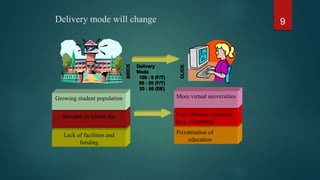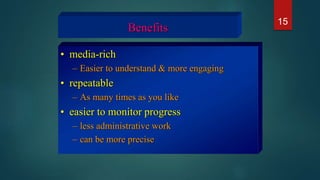E learning for education
- 1. E-learning for Education Praveen Kumar. G
- 2. What is E-learning? 2 The use of Internet technologies to deliver a broad array of solutions that enhance knowledge and performance Rosenberg, 2001 E-learning is Internet-enabled learning http://www.cisco.com
- 3. Truth of e-learning 3 Internet has started reshaping education. Education will not be the same in the next decade There is no going back. The traditional classroom has to be transformed Web-based Education Commission, US Many universities/colleges may not survive by the end of this decade
- 4. Internet Users will continue to grow 4 Table: Internet Users in Asia (2000) Country Number of Internet Users % population Hong Kong 3,460,000 48% Indonesia 400,000 0.18% China 17,000,000 1.3% India 4,500,000 0.45% Japan 38,000,000 30% Malaysia 1,500,000 7% Philippines 500,000 0.6% Singapore 1,850,000 44% South Korea 16,000,000 34% Taiwan 6,400,000 29% Thailand 1,000,000 1.6% Vietnam 100,000 0.13% Source: http://www.nua.ie
- 6. E-learning: Blended mode Chalk-and-board has long ruled the classrooms will not be eliminated Less emphasis 6 Interactive Digital Content: • more emphasis • on demand learning • interactive
- 7. National ICT Agenda 7 KNOWLEDGE-BASED ECNOOMY PEOPLE - Work Culture - ICT Skills - Knowledge worker - Learning Society - United, moral & ethical INFRASTRUCTURE - Communication - Fibre-Optic Cabling - Gigabit ATM - Satellite - Transport/Logistic - etc APPLICATION & CONTENT - Smart Schools - e-govt. - Smartcard - Tele-medicine - Others
- 8. Traditional & E-learning Approach 8 Traditional and E-learning approaches Traditional Classroom E-Learning Classroom • Physical – limited size • Synchronous • Unlimited • Anytime, anywhere Content • PowerPoint/transparency/etc • Textbooks/library • Video • Collaboration • Multimedia / simulation • Digital library • On demand • Syn & Asyn. Communication Personalisation • One learning path • Learning path and pace determined by learner
- 9. Delivery mode will change 9 Lack of facilities and funding Increase in tuition fee Growing student population Privatisation of education Cost effective solutions (e.g. e-learning) More virtual universities Delivery Mode 100 : 0 (F/T) 80 : 20 (F/T) 20 : 80 (DE)
- 10. Teaching aids will change 10 Blackboard OHP TV/VHS LCD PC Whiteboard
- 11. E-learning • In an on-line multimedia learning environment: – teaching & learning is ‘one-to-one’ (individual) – more interactivity (in normal classroom, it varies with the class size) – learner-centred – Learner monitoring & grading system 11
- 12. Benefits • Convenient – self-service (mix and match) – on-demand (anytime, anywhere) – private learning – self-paced – Flexibility: (modular package) 12
- 13. • Cost-effective – Virtual learning environment – Share lessons among schools – Reduce material cost – Reduce travel/accommodation costs Benefits 13
- 14. Benefits • Consistent – Central control of content – Same quality of content for all – Same quality of education for all 14
- 15. Benefits • media-rich – Easier to understand & more engaging • repeatable – As many times as you like • easier to monitor progress – less administrative work – can be more precise 15
- 16. Teacher’s Obligation incorporate ‘old’ & ‘new’ Lay foundation for Lifelong learning Encourage collaborative learning use all available technology Teacher’s Obligation 16
- 17. Building an e-learning culture 17 Learner: Self-directed Self-motivated Self-regulating Lifelong learning Teacher: Develop knowledge & skills Understand learning and its need Facilitate learning Create learning opportunities Administrator: Create Learning environment Provide ICT infrastructure Resources for lifelong learning Building an E-learning Culture
- 18. E-learning tools: E-mail Every teacher should have an e-mail account Communicate with students Communicate with parents Students can submit assignment Can have attachments Create a paperless environment Simple but effective Efficient and cost effective 18
- 19. E-learning tools: Chat Synchronous communication tool Communicate with students Communicate with parents More students participate Collaborative learning 19
- 20. E-learning tools: Online Forum Asynchronous discussion forum Teacher can create discussion groups Teacher could post a question and request students to comment Students can post their comments Can encourage community participation Collaborative learning can be fostered Feedback from diverse culture 20
- 21. E-learning Tools: Web Wide range of materials available Teacher will need to narrow down It is a resource centre Sharing of resources Supported by images, audio, simulation and multimedia 21
- 22. E-learning tools: Video Conference Can conduct a live lecture Communication with students Communication with parents Support by audio, chat and whiteboard Support sharing of applications Can be recorded and later be used for on demand lectures Demo… 22
- 23. Where to start? Traditional Pen and paper Personal presentation MS Word Use Kid pictures Beginning Use MS Publisher Use MS PowerPoint Use creative writing Regularly access the Internet Students can navigate your Network Students frequently use a Digital Camera Evolving I.C.T. is formally taught to every student Students manage the school Internet Students and teachers use a wide range of CD ROM Student can craft web pages 23
- 24. Where to start? Consolidating School website is current and reflects school culture School website has educational value for students and the wider community Students can use multi media Advanced Teacher use the Intranet to display and initiate learning Teachers can design web pages Students submit learning using floppy, Network, Print format Use selected software to source knowledge Use the Internet to compliment learning outcomes Use of personal web pages to link to a variety of program e-learning / digital classroom Teacher use the Intranet to initiate and measure learning E Mail is a focal educational exchange medium Students are able to manage and produce digitally edited movies Multimedia visual literacy is a valued learning focus Teachers can comfortably use digital multimedia to enhance learning 24
- 25. E-Learning SWOT Analysis 25 Strengths Ability to offer education to large numbers of students from distant locations. Lower costs (travel, instructor fees). Shorter courses mean less time commitment necessary from corporate students. Lower cost means education is more accessible to people with limited financial resources. Use best instructors making best courses available to all. Weaknesses Large commitment to technology needed from universities, corporations offering e- learning courses. Lack of face-to-face contact with students. Current technology does not support low-cost, high-bandwidth, synchronous student- teacher interaction.
- 26. Opportunities Ability to reach the world instantaneously with the latest news and technologies. Ability to train sales force and employees about product advancements. Access to courses from a variety of universities. Decrease long-term education expenses by shifting learning programs to the Web. Threats Lack of student interest. Equipment and technology requirements restrict adoption of e-learning. Lack of human interaction deters the learning process. Most corporate instructor-led courses last 4-5 days, comprehensive coverage of some topics could be lost in a shorter e-course. 26
- 27. 27


























